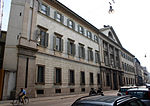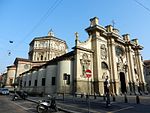Villa Necchi Campiglio

Villa Necchi Campiglio is a historic residence (house museum) located at via Mozart, 14, Milan. It was built between 1932 and 1935 as an independent single-family house designed by Piero Portaluppi, an important Milanese Rationalist architect, and is surrounded by a large private garden with a tennis court and swimming pool. This was the second swimming pool ever to be built in Milan after the municipal one, and the first to be built on private land.Among the personalities who were hosted there were Henry of Hesse, set designer for the Teatro alla Scala, who was housed during his stays in a room called the Prince's Room in his honor. There was also the Princess' Chamber, reserved for Princess Maria Gabriella of Savoy, a good friend of the Necchi sisters.
Excerpt from the Wikipedia article Villa Necchi Campiglio (License: CC BY-SA 3.0, Authors, Images).Villa Necchi Campiglio
Via Wolfgang Amadeus Mozart, Milan Municipio 1
Geographical coordinates (GPS) Address Phone number Website External links Nearby Places Show on map
Geographical coordinates (GPS)
| Latitude | Longitude |
|---|---|
| N 45.468267 ° | E 9.201854 ° |
Address
Villa Necchi Campiglio
Via Wolfgang Amadeus Mozart
20122 Milan, Municipio 1
Lombardy, Italy
Open on Google Maps











